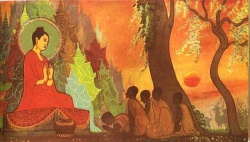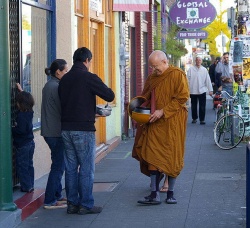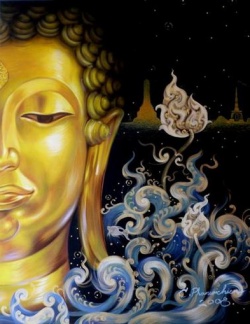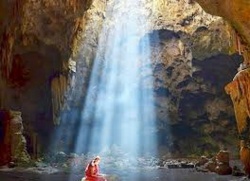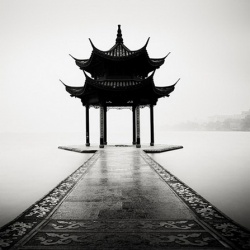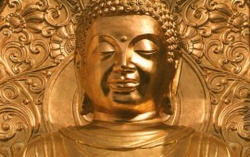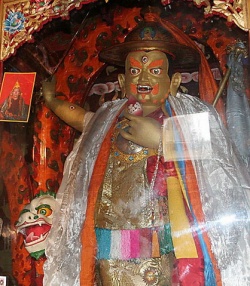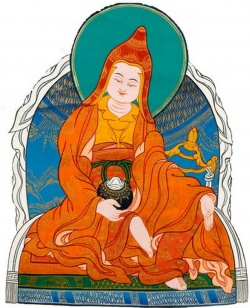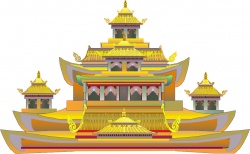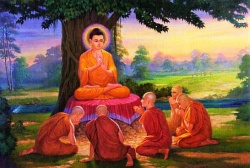Difference between revisions of "Theravada Buddhism; A Chronology"
| Line 21: | Line 21: | ||
: During the [[full-moon]] night of July, the [[Buddha]] delivers his first {{Wiki|discourse}} near [[Varanasi]], introducing the [[world]] to the [[Four Noble Truths]] and commencing a 45-year career of [[teaching]] the [[religion]] he called "[[Dhamma-vinaya]]." | : During the [[full-moon]] night of July, the [[Buddha]] delivers his first {{Wiki|discourse}} near [[Varanasi]], introducing the [[world]] to the [[Four Noble Truths]] and commencing a 45-year career of [[teaching]] the [[religion]] he called "[[Dhamma-vinaya]]." | ||
1 -544/-480 | 1 -544/-480 | ||
| − | : [[Parinibbana]] (Skt: [[Parinirvana]]; [[death]] and final [[release]]) of the [[Buddha]], at [[Kusinara]] (now Kusinagar, [[India]]) (age 80). <ref name="Source1" /><ref name="Source3">[[Pali Literature]] and [[Language]] by Wilhelm Geiger ({{Wiki|New Delhi}}: {{Wiki|Oriental}} [[Books]], 1978)</ref> | + | : [[Parinibbana]] (Skt: [[Parinirvana]]; [[death]] and final [[release]]) of the [[Buddha]], at [[Kusinara]] (now {{Wiki|Kusinagar}}, [[India]]) (age 80). <ref name="Source1" /><ref name="Source3">[[Pali Literature]] and [[Language]] by [[Wilhelm Geiger]] ({{Wiki|New Delhi}}: {{Wiki|Oriental}} [[Books]], 1978)</ref> |
: During the [[rains retreat]] following the [[Buddha's]] [[Parinibbana]], the [[First Council]] ([[sangayana]]) convenes at [[Rajagaha]], [[India]], during which 500 [[arahant]] [[bhikkhus]], led by Ven. [[Mahakassapa]], [[gather]] to recite the entire [[body]] of the [[Buddha's teachings]]. The {{Wiki|recitation}} of the [[Vinaya]] by Ven. [[Upali]] becomes accepted as the [[Vinaya Pitaka]]; the {{Wiki|recitation}} of the [[Dhamma]] by Ven. [[Ananda]] becomes established as the [[Sutta Pitaka]]. <ref name="Source1" /><ref name="Source4">Beginnings: the [[Pali]] [[Suttas]] by [[Samanera]] Bodhesako ({{Wiki|Kandy}}: [[Buddhist]] Publication {{Wiki|Society}}, 1984)</ref> | : During the [[rains retreat]] following the [[Buddha's]] [[Parinibbana]], the [[First Council]] ([[sangayana]]) convenes at [[Rajagaha]], [[India]], during which 500 [[arahant]] [[bhikkhus]], led by Ven. [[Mahakassapa]], [[gather]] to recite the entire [[body]] of the [[Buddha's teachings]]. The {{Wiki|recitation}} of the [[Vinaya]] by Ven. [[Upali]] becomes accepted as the [[Vinaya Pitaka]]; the {{Wiki|recitation}} of the [[Dhamma]] by Ven. [[Ananda]] becomes established as the [[Sutta Pitaka]]. <ref name="Source1" /><ref name="Source4">Beginnings: the [[Pali]] [[Suttas]] by [[Samanera]] Bodhesako ({{Wiki|Kandy}}: [[Buddhist]] Publication {{Wiki|Society}}, 1984)</ref> | ||
| Line 27: | Line 27: | ||
: 100 years after the [[Buddha's]] [[Parinibbana]] the [[Second Council]] convenes in [[Vesali]] to discuss controversial points of [[Vinaya]]. The first {{Wiki|schism}} of the [[Sangha]] occurs, in which the [[Mahasanghika]] school parts ways with the traditionalist [[Sthaviravadins]]. At issue is the Mahasanghika's reluctance to accept the [[Suttas]] and the [[Vinaya]] as the final authority on the [[Buddha's teachings]]. This {{Wiki|schism}} marks the first beginnings of what would later evolve into [[Mahayana Buddhism]], which would come to dominate [[Buddhism]] in northern {{Wiki|Asia}} ([[China]], [[Tibet]], [[Japan]], [[Korea]]). <ref name="Source1" /> | : 100 years after the [[Buddha's]] [[Parinibbana]] the [[Second Council]] convenes in [[Vesali]] to discuss controversial points of [[Vinaya]]. The first {{Wiki|schism}} of the [[Sangha]] occurs, in which the [[Mahasanghika]] school parts ways with the traditionalist [[Sthaviravadins]]. At issue is the Mahasanghika's reluctance to accept the [[Suttas]] and the [[Vinaya]] as the final authority on the [[Buddha's teachings]]. This {{Wiki|schism}} marks the first beginnings of what would later evolve into [[Mahayana Buddhism]], which would come to dominate [[Buddhism]] in northern {{Wiki|Asia}} ([[China]], [[Tibet]], [[Japan]], [[Korea]]). <ref name="Source1" /> | ||
294 -250 | 294 -250 | ||
| − | : [[Third Council]] is convened by [[King]] [[Asoka]] at [[Pataliputra]] ([[India]]). Disputes on points of [[doctrine]] lead to further {{Wiki|schisms}}, spawning the [[Sarvastivadin]] and [[Vibhajjavadin]] sects. The [[Abhidhamma Pitaka]] is recited at the Council, along with additional [[sections]] of the [[Khuddaka Nikaya]]. The {{Wiki|modern}} [[Pali]] [[Tipitaka]] is now [[essentially]] complete, although some [[scholars]] have suggested that at least two parts of the extant [[Canon]] — the [[Parivara]] in the [[Vinaya]], and the [[Apadana]] in the [[Sutta]] — may date from a later period. <ref name="Source1" /><ref name="Source4" /> | + | : [[Third Council]] is convened by [[King]] [[Asoka]] at [[Pataliputra]] ([[India]]). [[Disputes]] on points of [[doctrine]] lead to further {{Wiki|schisms}}, spawning the [[Sarvastivadin]] and [[Vibhajjavadin]] sects. The [[Abhidhamma Pitaka]] is recited at the Council, along with additional [[sections]] of the [[Khuddaka Nikaya]]. The {{Wiki|modern}} [[Pali]] [[Tipitaka]] is now [[essentially]] complete, although some [[scholars]] have suggested that at least two parts of the extant [[Canon]] — the [[Parivara]] in the [[Vinaya]], and the [[Apadana]] in the [[Sutta]] — may date from a later period. <ref name="Source1" /><ref name="Source4" /> |
297 -247 | 297 -247 | ||
: [[King]] [[Asoka]] sends his son, Ven. [[Mahinda]], on a [[mission]] to bring [[Buddhism]] to [[Sri Lanka]]; [[King Devanampiya Tissa]] of [[Sri Lanka]] is converted <ref name="Source5">[[Buddhism in Sri Lanka]] by H.R. Perera ({{Wiki|Kandy}}: [[Buddhist]] Publication {{Wiki|Society}}, 1966) </ref>. [[Asoka]] also sends envoys to Lower [[Burma]] and Central [[Thailand]] <ref name="Source1" />. | : [[King]] [[Asoka]] sends his son, Ven. [[Mahinda]], on a [[mission]] to bring [[Buddhism]] to [[Sri Lanka]]; [[King Devanampiya Tissa]] of [[Sri Lanka]] is converted <ref name="Source5">[[Buddhism in Sri Lanka]] by H.R. Perera ({{Wiki|Kandy}}: [[Buddhist]] Publication {{Wiki|Society}}, 1966) </ref>. [[Asoka]] also sends envoys to Lower [[Burma]] and Central [[Thailand]] <ref name="Source1" />. | ||
| Line 33: | Line 33: | ||
: Ven. [[Mahinda]] establishes the [[Mahavihara]] (Great [[Monastery]]) of [[Anuradhapura]], [[Sri Lanka]]. The [[Vibhajjavadin]] {{Wiki|community}} living there becomes known as the [[Theravadins]]. [[Mahinda]] compiles the first of the [[Tipitaka]] commentaries, in the [[Sinhala]] [[language]]. [[Mahinda's]] sister, Ven. [[Sanghamitta]], arrives in [[Sri Lanka]] with a cutting from the original [[Bo tree]], and establishes the [[bhikkhuni-sangha]] in [[Sri Lanka]].<ref name="Source1" /><ref name="Source5" /> | : Ven. [[Mahinda]] establishes the [[Mahavihara]] (Great [[Monastery]]) of [[Anuradhapura]], [[Sri Lanka]]. The [[Vibhajjavadin]] {{Wiki|community}} living there becomes known as the [[Theravadins]]. [[Mahinda]] compiles the first of the [[Tipitaka]] commentaries, in the [[Sinhala]] [[language]]. [[Mahinda's]] sister, Ven. [[Sanghamitta]], arrives in [[Sri Lanka]] with a cutting from the original [[Bo tree]], and establishes the [[bhikkhuni-sangha]] in [[Sri Lanka]].<ref name="Source1" /><ref name="Source5" /> | ||
444 -100 | 444 -100 | ||
| − | : Famine and {{Wiki|schisms}} in [[Sri Lanka]] point out the need for a written record of the [[Tipitaka]] to preserve the [[Buddhist]] [[religion]]. [[King]] Vattagamani convenes a [[Fourth Council]], in which 500 reciters and scribes from the [[Mahavihara]] write down the [[Pali]] [[Tipitaka]] for the first [[time]], on palm leaves. {4, 5, <ref name="Source6">The [[Path of Purification]] ([[Visuddhimagga]]) (Introduction) by Ven. [[Bhikkhu]] [[Ñanamoli]] ({{Wiki|Kandy}}: [[Buddhist]] Publication {{Wiki|Society}}, 1975) </ref> | + | : Famine and {{Wiki|schisms}} in [[Sri Lanka]] point out the need for a written record of the [[Tipitaka]] to preserve the [[Buddhist]] [[religion]]. [[King]] [[Vattagamani]] convenes a [[Fourth Council]], in which 500 reciters and scribes from the [[Mahavihara]] write down the [[Pali]] [[Tipitaka]] for the first [[time]], on palm leaves. {4, 5, <ref name="Source6">The [[Path of Purification]] ([[Visuddhimagga]]) (Introduction) by Ven. [[Bhikkhu]] [[Ñanamoli]] ({{Wiki|Kandy}}: [[Buddhist]] Publication {{Wiki|Society}}, 1975) </ref> |
544 1 | 544 1 | ||
: Common {{Wiki|Era}} (CE) begins; Year 1 AD. | : Common {{Wiki|Era}} (CE) begins; Year 1 AD. | ||
| Line 39: | Line 39: | ||
: [[Buddhist]] [[monastic]] {{Wiki|university}} at [[Nalanda]], [[India]] flourishes; remains a [[world]] center of [[Buddhist]] study for over 1,000 years. <ref name="Source1" /> | : [[Buddhist]] [[monastic]] {{Wiki|university}} at [[Nalanda]], [[India]] flourishes; remains a [[world]] center of [[Buddhist]] study for over 1,000 years. <ref name="Source1" /> | ||
ca. 1000 5th c. | ca. 1000 5th c. | ||
| − | : Ven. [[Buddhaghosa]] collates the various [[Sinhala]] commentaries on the [[Canon]] — drawing primarily on the [[Maha]] [[Atthakatha]] (Great Commentary) preserved at the [[Mahavihara]] — and translates them into [[Pali]]. This makes [[Sinhala]] [[Buddhist]] {{Wiki|scholarship}} available for the first [[time]] to the entire [[Theravadan]] [[world]] and marks the beginning of what will become, in the centuries to follow, a vast [[body]] of post-canonical [[Pali literature]]. [[Buddhaghosa]] also composes his {{Wiki|encyclopedic}}, though controversial, [[meditation manual]] [[Visuddhimagga]] (The [[Path of Purification]]). Vens. [[Buddhadatta]] and [[Dhammapala]] write additional commentaries and sub-commentaries. <ref name="Source7">[[Indian Buddhism]] (second edition) by {{Wiki|A.K. Warder}} ({{Wiki|Delhi}}: {{Wiki|Motilal Banarsidass}}, 1980) </ref> | + | : Ven. [[Buddhaghosa]] collates the various [[Sinhala]] commentaries on the [[Canon]] — drawing primarily on the [[Maha]] [[Atthakatha]] ([[Great Commentary]]) preserved at the [[Mahavihara]] — and translates them into [[Pali]]. This makes [[Sinhala]] [[Buddhist]] {{Wiki|scholarship}} available for the first [[time]] to the entire [[Theravadan]] [[world]] and marks the beginning of what will become, in the centuries to follow, a vast [[body]] of post-canonical [[Pali literature]]. [[Buddhaghosa]] also composes his {{Wiki|encyclopedic}}, though controversial, [[meditation manual]] [[Visuddhimagga]] (The [[Path of Purification]]). Vens. [[Buddhadatta]] and [[Dhammapala]] write additional commentaries and sub-commentaries. <ref name="Source7">[[Indian Buddhism]] (second edition) by {{Wiki|A.K. Warder}} ({{Wiki|Delhi}}: {{Wiki|Motilal Banarsidass}}, 1980) </ref> |
ca. 1100 600's | ca. 1100 600's | ||
: [[Buddhism in India]] begins a long, slow {{Wiki|decline}} from which it would never fully recover. <ref name="Source1" /> | : [[Buddhism in India]] begins a long, slow {{Wiki|decline}} from which it would never fully recover. <ref name="Source1" /> | ||
| Line 47: | Line 47: | ||
: The [[bhikkhu]] and [[bhikkhuni]] communities at [[Anuradhapura]] [[die]] out following invasions from {{Wiki|South India}}.<ref name="Source1" /><ref name="Source5" /> | : The [[bhikkhu]] and [[bhikkhuni]] communities at [[Anuradhapura]] [[die]] out following invasions from {{Wiki|South India}}.<ref name="Source1" /><ref name="Source5" /> | ||
1614 1070 | 1614 1070 | ||
| − | : [[Bhikkhus]] from {{Wiki|Pagan}} arrive in [[Polonnaruwa]], [[Sri Lanka]] to reinstate the obliterated [[Theravada]] [[ordination]] line on the island. <ref name="Source5" /> | + | : [[Bhikkhus]] from {{Wiki|Pagan}} arrive in [[Polonnaruwa]], [[Sri Lanka]] to reinstate the obliterated [[Theravada]] [[ordination]] line on the [[island]]. <ref name="Source5" /> |
1697 1153 | 1697 1153 | ||
: [[Buddhist Council]] (the 5th by [[Sri Lankan]] reckoning; the 7th by [[Thai]] reckoning) in [[Sri Lanka]]. <ref name="Source12">[http://www.accesstoinsight.org/lib/authors/kusalasaya/wheel085.html Buddhism in Thailand: Its Past and Its Present] by [[Karuna]] Kusalasaya ({{Wiki|Kandy}}, [[Sri Lanka]]: [[Buddhist]] Publication {{Wiki|Society}}, 2005), [http://www.accesstoinsight.org/lib/authors/kusalasaya/wheel085.html#fn-3 note 3]. </ref> | : [[Buddhist Council]] (the 5th by [[Sri Lankan]] reckoning; the 7th by [[Thai]] reckoning) in [[Sri Lanka]]. <ref name="Source12">[http://www.accesstoinsight.org/lib/authors/kusalasaya/wheel085.html Buddhism in Thailand: Its Past and Its Present] by [[Karuna]] Kusalasaya ({{Wiki|Kandy}}, [[Sri Lanka]]: [[Buddhist]] Publication {{Wiki|Society}}, 2005), [http://www.accesstoinsight.org/lib/authors/kusalasaya/wheel085.html#fn-3 note 3]. </ref> | ||
| Line 59: | Line 59: | ||
: {{Wiki|Pagan}} looted by {{Wiki|Mongol}} invaders; its {{Wiki|decline}} begins. <ref name="Source1" /> | : {{Wiki|Pagan}} looted by {{Wiki|Mongol}} invaders; its {{Wiki|decline}} begins. <ref name="Source1" /> | ||
ca. 1900 13th c. | ca. 1900 13th c. | ||
| − | : A forest-based [[Sri Lankan]] [[ordination]] line arrives in [[Burma]] and [[Thailand]]. [[Theravada]] spreads to [[Laos]]. [[Thai]] [[Theravada]] [[monasteries]] first appear in [[Cambodia]] shortly before the Thais win their {{Wiki|independence}} from the Khmers. <ref name="Source1" /> | + | : A forest-based [[Sri Lankan]] [[ordination]] line arrives in [[Burma]] and [[Thailand]]. [[Theravada]] spreads to [[Laos]]. [[Thai]] [[Theravada]] [[monasteries]] first appear in [[Cambodia]] shortly before the Thais win their {{Wiki|independence}} from the [[Wikipedia:Khmer people|Khmers]]. <ref name="Source1" /> |
ca. 2000 1400's | ca. 2000 1400's | ||
: Another {{Wiki|forest}} [[lineage]] is imported from [[Sri Lanka]] to Ayudhaya, the [[Thai]] capital. A new [[ordination]] line is also imported into [[Burma]]. <ref name="Source1" /> | : Another {{Wiki|forest}} [[lineage]] is imported from [[Sri Lanka]] to Ayudhaya, the [[Thai]] capital. A new [[ordination]] line is also imported into [[Burma]]. <ref name="Source1" /> | ||
2297 1753 | 2297 1753 | ||
| − | : [[King]] Kirti Sri Rajasinha obtains [[bhikkhus]] from the [[Thai]] court to reinstate the [[bhikkhu]] [[ordination]] line, which had [[died]] out in [[Sri Lanka]]. This is the origin of the [[Siyam Nikaya]]. <ref name="Source8" /> | + | : [[King]] [[Kirti Sri Rajasinha]] obtains [[bhikkhus]] from the [[Thai]] court to reinstate the [[bhikkhu]] [[ordination]] line, which had [[died]] out in [[Sri Lanka]]. This is the origin of the [[Siyam Nikaya]]. <ref name="Source8" /> |
2312 1768 | 2312 1768 | ||
: [[Burmese]] destroy Ayudhaya ([[Thai]] capital). | : [[Burmese]] destroy Ayudhaya ([[Thai]] capital). | ||
| Line 69: | Line 69: | ||
: [[King]] {{Wiki|Rama}} I, founder of the current {{Wiki|dynasty}} in [[Thailand]], obtains copies of the [[Tipitaka]] from [[Sri Lanka]] and sponsors a Council to standardize the [[Thai]] version of the [[Tipitaka]], copies of which are then donated to [[temples]] throughout the country. <ref name="Source1" /> | : [[King]] {{Wiki|Rama}} I, founder of the current {{Wiki|dynasty}} in [[Thailand]], obtains copies of the [[Tipitaka]] from [[Sri Lanka]] and sponsors a Council to standardize the [[Thai]] version of the [[Tipitaka]], copies of which are then donated to [[temples]] throughout the country. <ref name="Source1" /> | ||
2347 1803 | 2347 1803 | ||
| − | : Sri Lankans [[ordained]] in the [[Burmese]] city of Amarapura found the [[Amarapura Nikaya]] in [[Sri Lanka]] to supplement the [[Siyam Nikaya]], which admitted only [[brahmans]] from the Up Country highlands around {{Wiki|Kandy}}. <ref name="Source9">The {{Wiki|Forest}} [[Monks]] of [[Sri Lanka]]: An Anthropological and Historical Study by Michael Carrithers ({{Wiki|Delhi}}: {{Wiki|Oxford University Press}}, 1983) </ref> | + | : [[Sri Lankans]] [[ordained]] in the [[Burmese]] city of Amarapura found the [[Amarapura Nikaya]] in [[Sri Lanka]] to supplement the [[Siyam Nikaya]], which admitted only [[brahmans]] from the Up Country highlands around {{Wiki|Kandy}}. <ref name="Source9">The {{Wiki|Forest}} [[Monks]] of [[Sri Lanka]]: An Anthropological and Historical Study by Michael [[Carrithers]] ({{Wiki|Delhi}}: {{Wiki|Oxford University Press}}, 1983) </ref> |
2372 1828 | 2372 1828 | ||
: [[Thailand's]] {{Wiki|Prince}} {{Wiki|Mongkut}} (later [[King]] {{Wiki|Rama}} IV) founds the [[Dhammayut]] {{Wiki|movement}}, which would later become the [[Dhammayut]] [[Sect]]. <ref name="Source1" /> | : [[Thailand's]] {{Wiki|Prince}} {{Wiki|Mongkut}} (later [[King]] {{Wiki|Rama}} IV) founds the [[Dhammayut]] {{Wiki|movement}}, which would later become the [[Dhammayut]] [[Sect]]. <ref name="Source1" /> | ||
ca. 2400 1800's | ca. 2400 1800's | ||
| − | : [[Sri Lankan]] [[Sangha]] deteriorates under pressure from two centuries of {{Wiki|European}} colonial rule (Portuguese, Dutch, {{Wiki|British}}). <ref name="Source5" /> | + | : [[Sri Lankan]] [[Sangha]] deteriorates under pressure from two centuries of {{Wiki|European}} colonial {{Wiki|rule}} ([[Portuguese]], {{Wiki|Dutch}}, {{Wiki|British}}). <ref name="Source5" /> |
2406 1862 | 2406 1862 | ||
: {{Wiki|Forest}} [[monks]] headed by Ven. Paññananda go to [[Burma]] for reordination, returning to [[Sri Lanka]] the following year to found the Ramañña [[Nikaya]]. <ref name="Source9" /> First translation of the [[Dhammapada]] into a {{Wiki|Western}} [[language]] ({{Wiki|German}}). <ref name="Source2" /> | : {{Wiki|Forest}} [[monks]] headed by Ven. Paññananda go to [[Burma]] for reordination, returning to [[Sri Lanka]] the following year to found the Ramañña [[Nikaya]]. <ref name="Source9" /> First translation of the [[Dhammapada]] into a {{Wiki|Western}} [[language]] ({{Wiki|German}}). <ref name="Source2" /> | ||
| Line 83: | Line 83: | ||
: {{Wiki|Sir Edwin Arnold}} publishes his {{Wiki|epic}} poem Light of {{Wiki|Asia}}, which becomes a best-seller in {{Wiki|England}} and the {{Wiki|USA}}, stimulating popular {{Wiki|Western}} [[interest]] in [[Buddhism]]. | : {{Wiki|Sir Edwin Arnold}} publishes his {{Wiki|epic}} poem Light of {{Wiki|Asia}}, which becomes a best-seller in {{Wiki|England}} and the {{Wiki|USA}}, stimulating popular {{Wiki|Western}} [[interest]] in [[Buddhism]]. | ||
2424 1880 | 2424 1880 | ||
| − | : {{Wiki|Helena Blavatsky}} and [[Henry Steel Olcott]], founders of the [[Theosophical Society]], arrive in [[Sri Lanka]] from the {{Wiki|USA}}, embrace [[Buddhism]], and begin a campaign to restore [[Buddhism]] on the island by encouraging the establishment of [[Buddhist]] schools. <ref name="Source1" /> | + | : {{Wiki|Helena Blavatsky}} and [[Henry Steel Olcott]], founders of the [[Theosophical Society]], arrive in [[Sri Lanka]] from the {{Wiki|USA}}, embrace [[Buddhism]], and begin a campaign to restore [[Buddhism]] on the [[island]] by encouraging the establishment of [[Buddhist]] schools. <ref name="Source1" /> |
2425 1881 | 2425 1881 | ||
| − | : [[Pali Text Society]] is founded in {{Wiki|England}} by T.W. {{Wiki|Rhys Davids}}; most of the [[Tipitaka]] is published in {{Wiki|roman}} script and, over the next 100 years, in English translation. | + | : [[Pali Text Society]] is founded in {{Wiki|England}} by T.W. {{Wiki|Rhys Davids}}; most of the [[Tipitaka]] is published in {{Wiki|roman}} [[script]] and, over the next 100 years, in English translation. |
2435 1891 | 2435 1891 | ||
: [[Maha]] [[Bodhi]] {{Wiki|Society}} founded in [[India]] by the [[Sri Lankan]] lay follower [[Anagarika Dharmapala]], in an [[effort]] to reintroduce [[Buddhism]] to [[India]]. <ref name="Source1" /> | : [[Maha]] [[Bodhi]] {{Wiki|Society}} founded in [[India]] by the [[Sri Lankan]] lay follower [[Anagarika Dharmapala]], in an [[effort]] to reintroduce [[Buddhism]] to [[India]]. <ref name="Source1" /> | ||
| Line 105: | Line 105: | ||
: {{Wiki|Washington}} (D.C.) [[Buddhist]] [[Vihara]] founded — first [[Theravada]] [[monastic community]] in the {{Wiki|USA}}. (<ref name="Source11">[[World]] [[Buddhist]] Directory by The [[Buddhist]] [[Information]] Centre ({{Wiki|Colombo}}, [[Sri Lanka]]: [[Buddhist]] [[Information]] Centre, 1984) </ref>; and [[Bhavana]] {{Wiki|Society}} Brochure) | : {{Wiki|Washington}} (D.C.) [[Buddhist]] [[Vihara]] founded — first [[Theravada]] [[monastic community]] in the {{Wiki|USA}}. (<ref name="Source11">[[World]] [[Buddhist]] Directory by The [[Buddhist]] [[Information]] Centre ({{Wiki|Colombo}}, [[Sri Lanka]]: [[Buddhist]] [[Information]] Centre, 1984) </ref>; and [[Bhavana]] {{Wiki|Society}} Brochure) | ||
ca. 2514 1970's | ca. 2514 1970's | ||
| − | : Refugees from [[war]] in [[Vietnam]], [[Cambodia]], and [[Laos]] settle in {{Wiki|USA}} and {{Wiki|Europe}}, establishing many tight-knit [[Buddhist]] communities in the [[West]]. Ven. Taungpulu [[Sayadaw]] and Dr. Rina Sircar, from [[Burma]], establish the [[Taungpulu Kaba-Aye Monastery]] in Northern {{Wiki|California}}, {{Wiki|USA}}. Ven. [[Ajaan]] Chah establishes Wat Pah Nanachat, a {{Wiki|forest}} [[monastery]] in [[Thailand]] for training {{Wiki|Western}} [[monks]]. [[Insight]] [[Meditation]] {{Wiki|Society}}, a lay [[meditation]] center, is founded in {{Wiki|Massachusetts}}, {{Wiki|USA}}. Ven. [[Ajaan]] Chah travels to {{Wiki|England}} to establish a small [[community of monks]] at the Hamsptead [[Vihara]], which later moves to Sussex, {{Wiki|England}}, to become Wat Pah [[Cittaviveka]] (Chithurst {{Wiki|Forest}} [[Monastery]]). | + | : Refugees from [[war]] in [[Vietnam]], [[Cambodia]], and [[Laos]] settle in {{Wiki|USA}} and {{Wiki|Europe}}, establishing many tight-knit [[Buddhist]] communities in the [[West]]. Ven. Taungpulu [[Sayadaw]] and Dr. Rina Sircar, from [[Burma]], establish the [[Taungpulu Kaba-Aye Monastery]] in Northern {{Wiki|California}}, {{Wiki|USA}}. Ven. [[Ajaan]] Chah establishes [[Wat Pah Nanachat]], a {{Wiki|forest}} [[monastery]] in [[Thailand]] for {{Wiki|training}} {{Wiki|Western}} [[monks]]. [[Insight]] [[Meditation]] {{Wiki|Society}}, a lay [[meditation]] center, is founded in {{Wiki|Massachusetts}}, {{Wiki|USA}}. Ven. [[Ajaan]] Chah travels to {{Wiki|England}} to establish a small [[community of monks]] at the Hamsptead [[Vihara]], which later moves to Sussex, {{Wiki|England}}, to become Wat Pah [[Cittaviveka]] ([[Chithurst]] {{Wiki|Forest}} [[Monastery]]). |
ca. 2524 1980's | ca. 2524 1980's | ||
: Lay [[meditation centers]] grow in [[popularity]] in {{Wiki|USA}} and {{Wiki|Europe}}. First [[Theravada]] {{Wiki|forest}} [[monastery]] in the {{Wiki|USA}} ([[Bhavana]] {{Wiki|Society}}) is established in [[West]] Virginia. [[Amaravati Buddhist Monastery]] established in {{Wiki|England}} by Ven. [[Ajaan]] Sumedho ([[student]] of Ven. [[Ajaan]] Chah). | : Lay [[meditation centers]] grow in [[popularity]] in {{Wiki|USA}} and {{Wiki|Europe}}. First [[Theravada]] {{Wiki|forest}} [[monastery]] in the {{Wiki|USA}} ([[Bhavana]] {{Wiki|Society}}) is established in [[West]] Virginia. [[Amaravati Buddhist Monastery]] established in {{Wiki|England}} by Ven. [[Ajaan]] Sumedho ([[student]] of Ven. [[Ajaan]] Chah). | ||
ca. 2534 1990's – {{Wiki|present}} | ca. 2534 1990's – {{Wiki|present}} | ||
| − | : Continued {{Wiki|western}} expansion of the [[Theravada]] [[Sangha]]: [[monasteries]] from the [[Thai forest]] [[traditions]] established in {{Wiki|California}}, {{Wiki|USA}} ([[Metta]] {{Wiki|Forest}} [[Monastery]], founded by Ven. [[Ajaan]] Suwat; [[Abhayagiri Monastery]], founded by Ven. Ajaans Amaro and Pasanno). [[Buddhism]] meets cyberspace: online [[Buddhist]] [[information]] networks emerge; several editions of the [[Pali]] [[Tipitaka]] become available online. | + | : Continued {{Wiki|western}} expansion of the [[Theravada]] [[Sangha]]: [[monasteries]] from the [[Thai forest]] [[traditions]] established in {{Wiki|California}}, {{Wiki|USA}} ([[Metta]] {{Wiki|Forest}} [[Monastery]], founded by Ven. [[Ajaan]] Suwat; [[Abhayagiri Monastery]], founded by Ven. Ajaans Amaro and [[Pasanno]]). [[Buddhism]] meets cyberspace: online [[Buddhist]] [[information]] networks emerge; several editions of the [[Pali]] [[Tipitaka]] become available online. |
Latest revision as of 09:34, 24 February 2015
Theravada Buddhism A Chronology
For a general introduction to Theravada Buddhism, please see "What is Theravada Buddhism?".
-80 -624/-560
- The Bodhisatta (Sanskrit: Bodhisattva), or Buddha-to-be, is born in Lumbini (in present-day Nepal) as Siddhattha (Skt: Siddhartha) Gotama, a prince of the Sakya clan. [3][4]
-51 -595/-531
- The Bodhisatta renounces the householder life (age 29).
-45 -589/-525
- While meditating under the Bo tree in the forest at Gaya (now Bodhgaya, India) during the full-moon night of May, the Bodhisatta becomes the Buddha (age 36).
- During the full-moon night of July, the Buddha delivers his first discourse near Varanasi, introducing the world to the Four Noble Truths and commencing a 45-year career of teaching the religion he called "Dhamma-vinaya."
1 -544/-480
- Parinibbana (Skt: Parinirvana; death and final release) of the Buddha, at Kusinara (now Kusinagar, India) (age 80). [3][5]
- During the rains retreat following the Buddha's Parinibbana, the First Council (sangayana) convenes at Rajagaha, India, during which 500 arahant bhikkhus, led by Ven. Mahakassapa, gather to recite the entire body of the Buddha's teachings. The recitation of the Vinaya by Ven. Upali becomes accepted as the Vinaya Pitaka; the recitation of the Dhamma by Ven. Ananda becomes established as the Sutta Pitaka. [3][6]
100 -444/-380
- 100 years after the Buddha's Parinibbana the Second Council convenes in Vesali to discuss controversial points of Vinaya. The first schism of the Sangha occurs, in which the Mahasanghika school parts ways with the traditionalist Sthaviravadins. At issue is the Mahasanghika's reluctance to accept the Suttas and the Vinaya as the final authority on the Buddha's teachings. This schism marks the first beginnings of what would later evolve into Mahayana Buddhism, which would come to dominate Buddhism in northern Asia (China, Tibet, Japan, Korea). [3]
294 -250
- Third Council is convened by King Asoka at Pataliputra (India). Disputes on points of doctrine lead to further schisms, spawning the Sarvastivadin and Vibhajjavadin sects. The Abhidhamma Pitaka is recited at the Council, along with additional sections of the Khuddaka Nikaya. The modern Pali Tipitaka is now essentially complete, although some scholars have suggested that at least two parts of the extant Canon — the Parivara in the Vinaya, and the Apadana in the Sutta — may date from a later period. [3][6]
297 -247
- King Asoka sends his son, Ven. Mahinda, on a mission to bring Buddhism to Sri Lanka; King Devanampiya Tissa of Sri Lanka is converted [7]. Asoka also sends envoys to Lower Burma and Central Thailand [3].
304 -240
- Ven. Mahinda establishes the Mahavihara (Great Monastery) of Anuradhapura, Sri Lanka. The Vibhajjavadin community living there becomes known as the Theravadins. Mahinda compiles the first of the Tipitaka commentaries, in the Sinhala language. Mahinda's sister, Ven. Sanghamitta, arrives in Sri Lanka with a cutting from the original Bo tree, and establishes the bhikkhuni-sangha in Sri Lanka.[3][7]
444 -100
- Famine and schisms in Sri Lanka point out the need for a written record of the Tipitaka to preserve the Buddhist religion. King Vattagamani convenes a Fourth Council, in which 500 reciters and scribes from the Mahavihara write down the Pali Tipitaka for the first time, on palm leaves. {4, 5, [8]
544 1
- Common Era (CE) begins; Year 1 AD.
744 200
- Buddhist monastic university at Nalanda, India flourishes; remains a world center of Buddhist study for over 1,000 years. [3]
ca. 1000 5th c.
- Ven. Buddhaghosa collates the various Sinhala commentaries on the Canon — drawing primarily on the Maha Atthakatha (Great Commentary) preserved at the Mahavihara — and translates them into Pali. This makes Sinhala Buddhist scholarship available for the first time to the entire Theravadan world and marks the beginning of what will become, in the centuries to follow, a vast body of post-canonical Pali literature. Buddhaghosa also composes his encyclopedic, though controversial, meditation manual Visuddhimagga (The Path of Purification). Vens. Buddhadatta and Dhammapala write additional commentaries and sub-commentaries. [9]
ca. 1100 600's
- Buddhism in India begins a long, slow decline from which it would never fully recover. [3]
ca. 1100? 1400? 6th c.? 9th c.?
- Dhammapala composes commentaries on parts of the Canon missed by Buddhaghosa (such as the Udana, Itivuttaka, Theragatha, and Therigatha), along with extensive sub-commentaries on Buddhaghosa's work. [9]
1594 1050
- The bhikkhu and bhikkhuni communities at Anuradhapura die out following invasions from South India.[3][7]
1614 1070
- Bhikkhus from Pagan arrive in Polonnaruwa, Sri Lanka to reinstate the obliterated Theravada ordination line on the island. [7]
1697 1153
- Buddhist Council (the 5th by Sri Lankan reckoning; the 7th by Thai reckoning) in Sri Lanka. [10]
1708 1164
- Polonnaruwa destroyed by foreign invasion. With the guidance of two monks from a forest branch of the Mahavihara sect — Vens. Mahakassapa and Sariputta — King Parakramabahu reunites all bhikkhus in Sri Lanka into the Mahavihara sect. [3][11]
1780 1236
1823 1279
1831 1287
ca. 1900 13th c.
- A forest-based Sri Lankan ordination line arrives in Burma and Thailand. Theravada spreads to Laos. Thai Theravada monasteries first appear in Cambodia shortly before the Thais win their independence from the Khmers. [3]
ca. 2000 1400's
- Another forest lineage is imported from Sri Lanka to Ayudhaya, the Thai capital. A new ordination line is also imported into Burma. [3]
2297 1753
- King Kirti Sri Rajasinha obtains bhikkhus from the Thai court to reinstate the bhikkhu ordination line, which had died out in Sri Lanka. This is the origin of the Siyam Nikaya. [11]
2312 1768
2321 1777
- King Rama I, founder of the current dynasty in Thailand, obtains copies of the Tipitaka from Sri Lanka and sponsors a Council to standardize the Thai version of the Tipitaka, copies of which are then donated to temples throughout the country. [3]
2347 1803
- Sri Lankans ordained in the Burmese city of Amarapura found the Amarapura Nikaya in Sri Lanka to supplement the Siyam Nikaya, which admitted only brahmans from the Up Country highlands around Kandy. [12]
2372 1828
- Thailand's Prince Mongkut (later King Rama IV) founds the Dhammayut movement, which would later become the Dhammayut Sect. [3]
ca. 2400 1800's
- Sri Lankan Sangha deteriorates under pressure from two centuries of European colonial rule (Portuguese, Dutch, British). [7]
2406 1862
- Forest monks headed by Ven. Paññananda go to Burma for reordination, returning to Sri Lanka the following year to found the Ramañña Nikaya. [12] First translation of the Dhammapada into a Western language (German). [4]
2412 1868
- Buddhist Council (the 5th by Burmese reckoning) is held at Mandalay, Burma; Pali Canon is inscribed on 729 marble slabs. [4]
2417 1873
- Ven. Mohottivatte Gunananda defeats Christian missionaries in a public debate, sparking a nationwide revival of Sri Lankan pride in its Buddhist traditions. [11]
2423 1879
- Sir Edwin Arnold publishes his epic poem Light of Asia, which becomes a best-seller in England and the USA, stimulating popular Western interest in Buddhism.
2424 1880
- Helena Blavatsky and Henry Steel Olcott, founders of the Theosophical Society, arrive in Sri Lanka from the USA, embrace Buddhism, and begin a campaign to restore Buddhism on the island by encouraging the establishment of Buddhist schools. [3]
2425 1881
- Pali Text Society is founded in England by T.W. Rhys Davids; most of the Tipitaka is published in roman script and, over the next 100 years, in English translation.
2435 1891
- Maha Bodhi Society founded in India by the Sri Lankan lay follower Anagarika Dharmapala, in an effort to reintroduce Buddhism to India. [3]
2443 1899
ca. 2444 ca. 1900
2445 1902
- King Rama V of Thailand institutes a Sangha Act that formally marks the beginnings of the Mahanikaya and Dhammayut sects. Sangha government, which up to that time had been in the hands of a lay official appointed by the king, is handed over to the bhikkhus themselves.
2493 1949
- Mahasi Sayadaw becomes head teacher at a government-sponsored meditation center in Rangoon, Burma. [13]
2498 1954
- Burmese government sponsors a Buddhist Council (the 6th by Burmese and Sri Lankan reckoning) in Rangoon.
2500 1956
- Buddha Jayanti Year, commemorating 2,500 years of Buddhism.
2502 1958
- Ven. Nyanaponika Thera establishes the Buddhist Publication Society in Sri Lanka to publish English-language books on Theravada Buddhism. Sarvodaya Shramadana Movement is founded in Sri Lanka to bring Buddhist ideals to bear in solving pressing social problems. Two Germans ordain at the Royal Thai Embassy in London, becoming the first to take full Theravada ordination in the West. [3][4]
ca. 2504 1960's [14]
- Washington (D.C.) Buddhist Vihara founded — first Theravada monastic community in the USA. ([15]; and Bhavana Society Brochure)
ca. 2514 1970's
- Refugees from war in Vietnam, Cambodia, and Laos settle in USA and Europe, establishing many tight-knit Buddhist communities in the West. Ven. Taungpulu Sayadaw and Dr. Rina Sircar, from Burma, establish the Taungpulu Kaba-Aye Monastery in Northern California, USA. Ven. Ajaan Chah establishes Wat Pah Nanachat, a forest monastery in Thailand for training Western monks. Insight Meditation Society, a lay meditation center, is founded in Massachusetts, USA. Ven. Ajaan Chah travels to England to establish a small community of monks at the Hamsptead Vihara, which later moves to Sussex, England, to become Wat Pah Cittaviveka (Chithurst Forest Monastery).
ca. 2524 1980's
- Lay meditation centers grow in popularity in USA and Europe. First Theravada forest monastery in the USA (Bhavana Society) is established in West Virginia. Amaravati Buddhist Monastery established in England by Ven. Ajaan Sumedho (student of Ven. Ajaan Chah).
ca. 2534 1990's – present
- Continued western expansion of the Theravada Sangha: monasteries from the Thai forest traditions established in California, USA (Metta Forest Monastery, founded by Ven. Ajaan Suwat; Abhayagiri Monastery, founded by Ven. Ajaans Amaro and Pasanno). Buddhism meets cyberspace: online Buddhist information networks emerge; several editions of the Pali Tipitaka become available online.
Footnotes
- ↑ BE = Buddhist Era. Year 1 of the Buddhist Era calendar is the year of the Buddha's Parinibbana (death and final release), which occurred in the Buddha's eightieth year (480 BCE according to the "historical" timeline; 544 BCE by tradition). The actual date of the Buddha's birth is unknown. According to Buddhist tradition, the Buddha's birth took place in 624 BCE, although some recent estimates place the Buddha's birth much later — perhaps as late as 448 BCE {1}. 560 BCE is one commonly accepted date for the Buddha's birth, and the "historical" date for that event that I adopt here. Events in the timeline prior to -250 CE are shown with two CE dates: the date based on the "traditional" nativity of 624 BCE, followed by the date based on the "historical" date of 560 BCE. After -250 CE the "historical" date is dropped, since these dates are more appropriate only in discussions of earlier events. To calculate the CE date corresponding to an event in the Buddhist traditional calendar, subtract 544 years from the BE date. The BE dates of well-documented historical events (particularly those in the twentieth century) may be off by one year, since the CE and BE calendars start their years on different months (January and May, respectively).
- ↑ CE = Common Era. Year 1 of the Common Era corresponds with the year 1 AD (Anno Domini) in the Christian calendar. -1 CE (or 1 BCE — "Before the Common Era") corresponds with the year 1 BC ("Before Christ"). By convention there is no year zero; the day after 31 December 1 BCE is 1 January 1 CE.
- ↑ 3.00 3.01 3.02 3.03 3.04 3.05 3.06 3.07 3.08 3.09 3.10 3.11 3.12 3.13 3.14 3.15 3.16 3.17 3.18 3.19 3.20 The Buddhist Religion: A Historical Introduction (fourth edition) by R.H. Robinson & W.L. Johnson (Belmont, California: Wadsworth, 1996)
- ↑ 4.0 4.1 4.2 4.3 4.4 The Buddha's Way by H. Saddhatissa (London: Allen & Unwin, 1971)
- ↑ Pali Literature and Language by Wilhelm Geiger (New Delhi: Oriental Books, 1978)
- ↑ 6.0 6.1 Beginnings: the Pali Suttas by Samanera Bodhesako (Kandy: Buddhist Publication Society, 1984)
- ↑ 7.0 7.1 7.2 7.3 7.4 Buddhism in Sri Lanka by H.R. Perera (Kandy: Buddhist Publication Society, 1966)
- ↑ The Path of Purification (Visuddhimagga) (Introduction) by Ven. Bhikkhu Ñanamoli (Kandy: Buddhist Publication Society, 1975)
- ↑ 9.0 9.1 Indian Buddhism (second edition) by A.K. Warder (Delhi: Motilal Banarsidass, 1980)
- ↑ Buddhism in Thailand: Its Past and Its Present by Karuna Kusalasaya (Kandy, Sri Lanka: Buddhist Publication Society, 2005), note 3.
- ↑ 11.0 11.1 11.2 11.3 Theravada Buddhism: A Social History from Ancient Benares to Modern Colombo by Richard Gombrich (London and New York: Routledge and Kegan Paul, 1988)
- ↑ 12.0 12.1 The Forest Monks of Sri Lanka: An Anthropological and Historical Study by Michael Carrithers (Delhi: Oxford University Press, 1983)
- ↑ The Progress of Insight by Mahasi Sayadaw (Kandy: Buddhist Publication Society, 1994)
- ↑ Events of the last few decades are still too recent to claim any historical significance.
- ↑ World Buddhist Directory by The Buddhist Information Centre (Colombo, Sri Lanka: Buddhist Information Centre, 1984)
Source
"Theravada Buddhism: A Chronology". Access to Insight (Legacy Edition), 30 November 2013, http://www.accesstoinsight.org/history.html .
